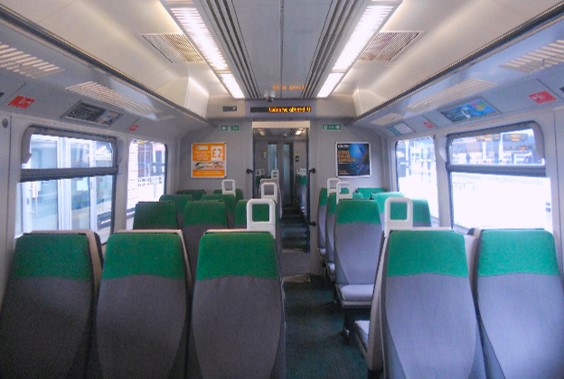BRISTOL TO PORTISHEAD RAILWAY – PAST AND FUTURE
Brunel had proposed a pier at Portishead linked by a railway to Bristol as early as 1839, but he died before the line was built. The population of Portishead in 1861 was only 1201, so a pier to link with Channel shipping was the reason for the new rail branch project.
In the 17th and 18th centuries Bristol harbour was paramount as the focus of international trade with the “New World”. However the city centre dock location, and the difficult tidal negotiation of the Avon valley, were increasingly a constraint on development, particularly as larger vessels came into use. A number of alternative schemes were put forward without success, but in 1846 the Portbury Pier and Railway Company obtained parliamentary authority to build a floating pier near Portbury, and a railway to connect it to Bristol.
In 1846 there was a collapse of investor confidence following the period of railway mania, and finance for the work could not be raised and the Company was dissolved.
In 1849 a small stone pier was built at Portishead, and packet steamers unloaded passengers there from time to time, but this did little to reduce the desire to improve Bristol’s port facilities, and competing factions tried to get approval for their schemes. In July 1862 the Bristol Port Railway and Pier Company obtained parliamentary authority for a railway on the eastern side of the River Avon from “Clifton” to a new dock at Avonmouth. This line opened in March 1865.
Those who favoured a port on the western side of the River Avon were not deterred by the progress of the alternative, and formulated a scheme for a dock at Portbury, and a railway to serve it running from a junction with the Bristol and Exeter Railway (at Bedminster), with a branch to Portishead. The company was to be the Bristol and Portishead Pier and Railway Company. This scheme easily got its authorising Act of Parliament on 29th June 1863, with a capital of £300,000.

The full line was built as a broad-gauge single line and was opened to Portishead in 1867, (about 3 years after the Clifton Suspension Bridge opened) and to the docks in 1879. The line was approximately 9.5 miles long to Portishead with an additional half a mile to the docks. Initially there were stations at Clifton Bridge, Pill, Portbury and Portishead.
The pier at Portishead came into used in 1868 with steamers running to Cardiff, Newport and Ilfracombe.
Portishead Docks opened in 1879 when the line was extended to the docks and pier.
The train service in 1870 was 8 trains each way daily, with a journey time of 30-35 minutes. There was only one train on Sundays and this returned to Bristol leaving at 8.30pm.
10 years after the line was opened the Great Western Railway progressively converted its main line and branches to standard gauge (4ft 8.5 inches) as at present, and the Portishead line was converted in just 3 days. The line finally became part of GWR in 1884.
Ashton Gate Station was opened in 1906 and Portbury shipyard station was opened in 1918 to serve the shipyard being built during WW1. The shipyard was never completed and the shipyard station closed in 1923.
Ham Green Halt opened in 1926 to serve the hospital and Nightingale Valley halt just north of Clifton Suspension Bridge opened in 1928 but closed in 1932.
The original Portishead station was demolished in 1954 to enable access to the Portishead B Power Station and a replacement station was built where the Waitrose petrol station now stands. This railway station opened on 1954 but did not have a very long life as the line was closed to passengers in1964 and to normal goods on 1967. Fortunately the line was not taken up and remained open for private freight from the docks until 1981. In 1985 a series of steam excursions ran along the line as part of the GWR 150 celebrations, and these were the last commercial trains usage before the line was rebuilt.
Once the Royal Portbury Dock had become fully established it became viable to reopen the branch line to enable cars to be transported from the docks. At a cost of £21m the line reopened in 2002 but only as far as Portbury Docks, and for freight only. The remaining 3.3 miles of old track was then protected by local planning policies and, when the site of the 1954 Portishead station was redeveloped as the Waitrose supermarket, a nearby site was safeguarded for the potential new station.
That is the past now for the future.
Re-opening is going ahead as a key part (Phase 1b) of the METROWEST project to link and upgrade the railway systems in the Bristol area.
What will the new railway be like?

- 10 miles (14km) of line from Portishead to Temple Meads.
- 23 minutes journey time including stops at Pill, Parsons Street and Bedminster.
- New stations at Portishead and Pill
- An hourly service with some additional trains at peak periods
- Relatively modern (refurbished) three carriage diesel trains with 280 seats initially although stations will be constructed to cater for 5 carriage (450 seats) trains in the future.
- Six trains will be required.
- Trains to operate weekdays for 18 hrs per day from approx. 6 am.to 11.30 pm . Sundays 10 hrs.
- Speed of 75 mph from Portishead to Pill but only 30 mph from Pill to Ashton Vale
- The line will have 4 tunnels, 3 viaducts, 12 underbridges, 13 overbridges (and the Gorge!!)
- Longer term bi modal trains are likely and the line could be electrified
The line is expected to re-open in 2026.